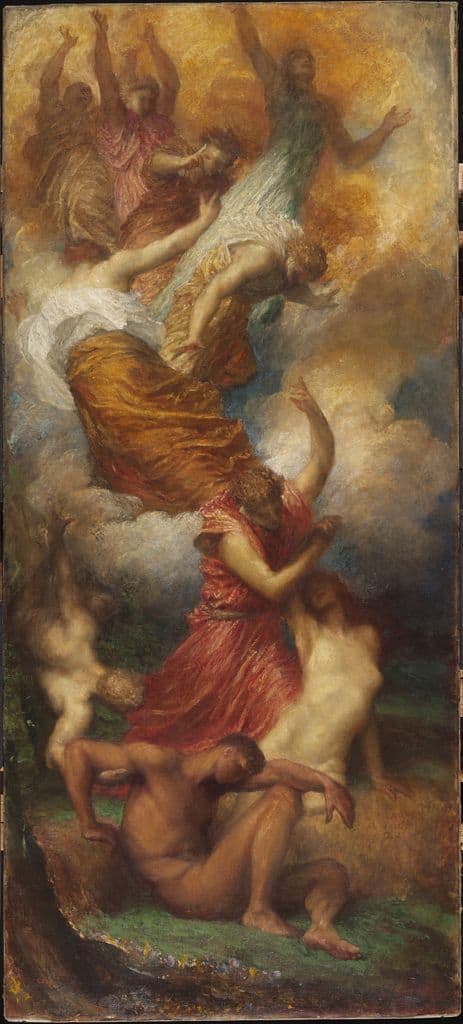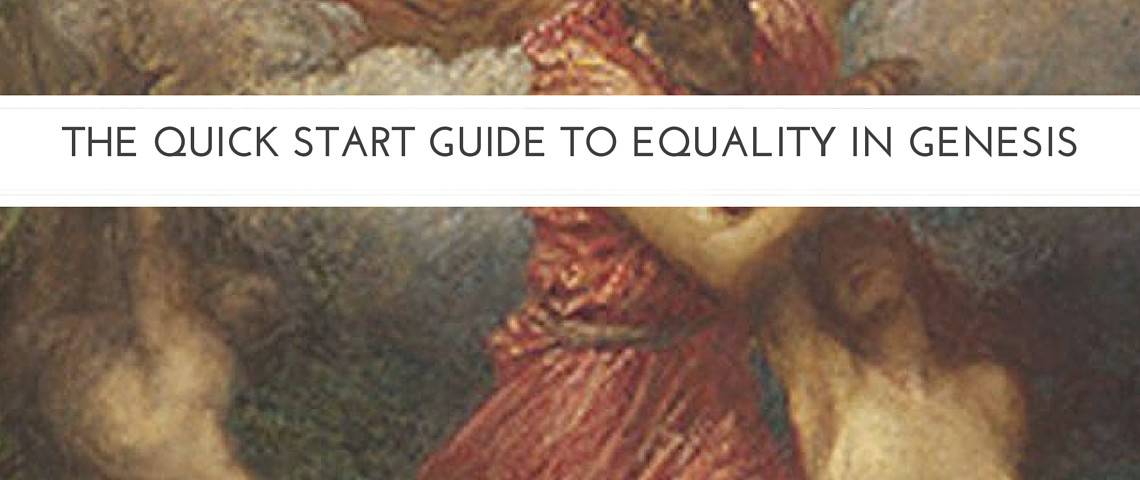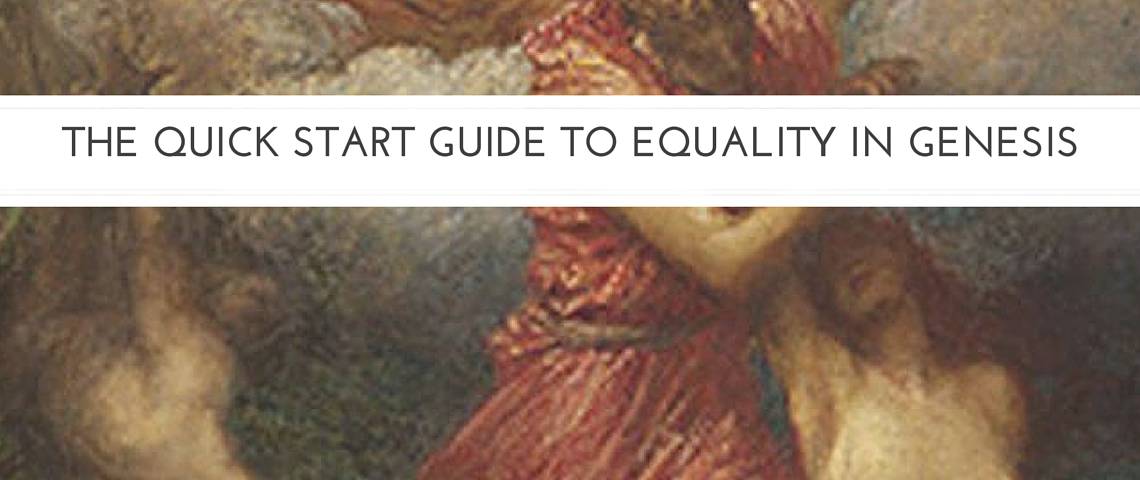The creation accounts in Genesis are of utmost importance when discussing gender relations within the Church.
“Creation order” is a foundational claim of complementarians, who root their beliefs in the idea that since man was created first, it means that men must lead women. But does Genesis truly reveal a God-ordained male headship through creation order? A close look into the creation account will provide us with a fuller understanding of God’s intentions for men and women.
Genesis 1:27 states that, “God created mankind in His own image, in the image of God He created him; male and female He created them”. Verse 28 goes on to say that God blessed “them” and spoke to “them”. This is the first mention of mankind. It’s important to see that male and female are mentioned, and the blessing that was bestowed on “them”.
The Hebrew word used for mankind in verse 27 is “‘adam” which refers to humanity as a whole [1].
We don’t see the proper noun, Adam, used until Genesis 4:25, so this common noun refers to the whole human race. One thing that is important to note is that the Hebrew language does not contain a gender neutral pronoun, therefore the word mankind was used.
Many complementarians do not refer to Genesis 1 in the formation of their doctrine, unless it is to make the announcement that God created Adam first, not necessarily acknowledging the fact that the more accurate definition of ‘adam would be humankind. Egalitarians find Genesis 1 to be very telling of God’s heart for equality because these verses make it clear that both men and women were created in God’s image, after which he blessed them.
The blessing of Genesis 1 was given to both male and female, demonstrating God’s heart towards us, and revealing the creation of both in God’s image.
Genesis 2:18-25, the more in-depth account of the creation of woman, is where much of the complementarian position originates, but modern English translations of the Bible do not do this passage justice. Genesis 2:18 is translated, “The Lord God said, ‘It is not good for the man to be alone; I will make him a helper suitable for him’”. The popular King James Version uses the phrase “help meet” which is often the terminology used in Christian circles when referring to a wife (KJV, Gen. 2.18). Help meet, or its common alternate “helpmate”, reduces a woman to a role of simply helping a man, indicating a subservient status.
But this doesn’t even begin to express full effect of “ezer kenegdo”, the Hebrew phrase used here, which holds much more meaning than a simple helper.

“Ezer” is a term that was often used in reference to God being Israel’s help in times of war. This isn’t a term of subjugation or of emphasis on the person being helped, but instead an empowering presence, a presence that assists when the subject is unable to get the desired result. When paired with the word “kenegdo” which means, “a compatible partner (assistant or protector at his own level)”, we see that this actually indicates comparable operating forces; equality. A breakdown of the word kenegdo, kemo meaning “the same as” and negdo meaning “corresponding, equal and adequate to him”, shows a double emphasis in the equality of women with men. The accurate translation of this Hebrew phrase makes more of a case for equality than it does for male authority. (Read more about the origins and meaning of ezer kenegdo here)
Genesis 2:19 speaks of man naming the animals, which was a direct result of the blessing of dominion declared in Genesis 1. Man exerted his authority over the animals that God created, but through this activity, he noticed that he could not find a suitable partner. God held the solution to the problem of loneliness and lack of human relationship, and removed a portion of man while he slept. Genesis 2:22 states that God, “fashioned into a woman the rib which he had taken from man”. This formation of woman was the culmination of all creation.
Yet again we find that the English word “rib” used here doesn’t adequately depict what was taken from man.
The Hebrew word used is “zela” which often means “a component, or more often, a side-wall” (alternatively, a chamber), indicating that more than simply a rib was taken [2]. Many scholars believe that the entire female essence was removed from man and fashioned into a woman. This would mean that the “mankind” in chapter 1 could have been an undifferentiated or androgynous person, with the blessing of male and female being a declaration in anticipation of the separation of the sexes in Genesis 2. The woman was then brought to the man who said, “This is now bone of my bone and flesh of my flesh; she shall be called woman, because she was taken out of man”. The Hebrew words used for woman and man here are “ishshah” and “ish”, respectively [3]. This is the first time that a specifically male reference is made, and it happens at the time of the creation or extraction of woman. (Up to this point, the more generic “adam” was used.) Instead of pointing out differences, I think the man was actually pointing out similarities. They were both two of the same kind, and suitable for each other. Man was identifying woman as “of himself”.
Complementarians like to say that the man asserts his authority over woman in Genesis 2:23. This simply isn’t so.
What sets humans apart from all other species? We are identified by our proper names! Man was identifying woman as part of himself, which is unlike the naming formulas laid out in the Bible (typically “X called his name Y”). This would look like “Adam called her name Eve”, but this doesn’t happen until after the fall. Genesis 3:20 shows the proper naming of Eve, which follows the fall and the declaration of the curse.
Genesis 2:24 says, “for this reason a man shall leave his father and his mother, and be joined to his wife; and they shall become one flesh”. Bible scholars note that “become one flesh” is actually in past tense, and to expand, they add “as they once were” or “as they once were at the beginning of creation” [2].
Genesis is a beautiful treasure trove of gender equality!
God in all of His glory, deemed humans as worthy to carry His image. He created men and women in this divine image, then separated us, to be joined together to become one in marriage. Although complementarians tell a different account of creation, the original Hebrew language seems very telling of God’s heart towards equality.
When looking at Genesis, men can see that they don’t have to rule over women and bear the pressure of the sole responsible party. Genesis reveals that the woman was not an after-thought or a housekeeper only meant for subservience, but beautifully included in the master plan.
When joined together in unity, men and women offer a completed picture of the image of God to the world, and what a beautiful picture that is!
References
1. Fee, Gordon D., Pierce, Ronald W., Groothuis, Rebecca Merrill, eds. Discovering Biblical Equality: Complementarity without Hierarchy. Downers Grove: InterVarsity Press 2005.]
2. Reisenberger, Azila Talit. “The Creation of Adam as Hermaphrodite–And Its Implications for Feminist Theology.” Judaism 42.4 (1993): 447-452. ATLA Religion Database with ATLASerials. Web. 15 July 2015.
3. Kvam, Kristen E., Schearing, Linda S., and Ziegler, Valarie H. Eve and Adam: Jewish, Christian, and Muslim Readings on Genesis and Gender. Bloomington: Indiana University Press, 1999.





12 responses to “The Quick Start Guide to Equality in Genesis”
Hannah, this is one of the most interesting and empowering explanations of the Genesis story and one which has so much depth entwined within it. I appreciate you pointing out that adam did not become a proper name until after the Fall, which is something I have noticed also.
I am looking forward to reading your book and your blog, and am reposting to Kyria.
Great post with a clear and concise break down of the egalitarianism view! As one who hasn’t really talked or study the subject I was never for not against but neutral on the subject. To throw a New Testament reference I often use Galatians 3:28 to point out the unity of men and women in Christ. It is amazing the unity that comes out of diversity when God creates and sets forth things. Created in the image and likeness of God….how can one image be less or more than another image. It’s one image!
Hi Hannah,
Thanks for a good and thoughtful post. Clearly this is something you’ve put both your mind and your heart into! It brought up a few new ideas for me, which is always a good thing.
I agree 100% that God created man and woman to be equal, and that this remains the divine ideal. And I don’t think it’s at all coincidental that in this new era of humankind, we’re pushing back toward that original ideal of gender equality, and even achieving it here and there–though in other areas it remains an unachieved ideal.
About the creation stories, though I generally arrive at the same conclusion you do related to the ultimate God-created equality of man and woman, I arrive at it through a somewhat different route.
Specifically, though I think the interpretation of the Hebrew word ezer that you present here is certainly possible and very thought-provoking, it’s a somewhat difficult argument to make, not the least because of Paul’s statement in 1 Corinthians 11:2-16, quoted by Marg in an earlier comment:
Biblically and historically, woman as “helpmeet” for man has been so commonly interpreted to mean that she was created as a (secondary) helper for man that it’s going to be very hard to turn that interpretation around convincingly. (Still, a new way to understand ezer is something I take away from your article.)
However, there is another route to understanding the devolution of the relationship between man and woman from our original God-given equality to a state of man ruling over woman. That is to make it a three-step process, from Genesis 1:26-28 (the original creation of man and woman as equals), down to Genesis 2:18-24 (the formation of woman out of man), and then all the way down to Genesis 3:16, in which man becomes a ruler over woman.
That route is to recognize:
There are actually two distinct creation stories, Genesis 1:1-2:3 and Genesis 2:4-25, and the second is not a retelling of the first, but a wholly new story of its own, and,
The creation of woman out of man in the second part of Genesis 2 comes after the first pronouncement in the Bible that something is not good, which occurs in Genesis 2:18; and it therefore represents a step down from the original creation of man and woman in Genesis 1:26-28.
Biblical literalists commonly distinguish between pre-Fall and post-Fall humanity in their arguments about the relationship between man and woman. But they regularly fail to distinguish between the first and second creation stories, lumping them together as if both were telling the same story.
They’re not.
Genesis 2 is a completely different creation story than Genesis 1. Even the order of creation is very different–and it cannot be reconciled with the order of creation in Genesis 1.
The second part of Genesis 2, starting with verse 18, tells a very different story about the creation of the sexes than does the first creation story. Recognizing this is key to understanding how humans fell step-by-step from the original state of gender equality in which God created us to the fallen state of great gender inequality that has been the unfortunate reality for most of human history.
If you’re interested in a fuller version of the above views, I take them up in greater detail in two articles on my blog that follow one from the other:
What are the Roles of Men and Women toward Each Other and in Society?
and:
Man, Woman, and the Two Creation Stories of Genesis
I hope you’ll find some new and interesting ideas in these articles, just as I found some new and interesting ideas in yours.
Hannah, I really appreciate your explanation of the man’s declaration concerning the woman. In essence he said, “Hey, she’s like me!” That clears up some of the problem with trying to find an equal helper among the animals, They aren’t human.
Interesting. I see this subject reappear about once a year in some online forum, as if this understanding of the Genesis account was something new. As if someone just unearthed an ancient scroll with a new revelation. This is not the case.
I really enjoyed this. I’ve studied the Hebrew terms some, but never made the connection that you did to the “creation order” argument. If the female essence was a part of adam (mankind), Adam (as the man separated from that female essence) could be said to have been created at the same time as Eve. On the other hand, if there is only one of something in existence, does it need a name? Did the naming of the humans come because now there were two and it was necessary to differentiate them (male and female)? I’m intrigued. Thanks for giving me something to ponder.
It is interesting – no, fascinating – to see that in a correct translation God created us equally in the beginning.
For a good exegesis of Genesis 1 and 2, which explains that man and woman are equal in one and the same human nature before and after sexual differentiation, see John Paul II’s Theology of the Body. For example, directly applicable to this post:
“Corporality and sexuality are not completely identified. Although the human body in its normal constitution, bears within it the signs of sex and is by its nature male or female, the fact, however, that man is a “body” belongs to the structure of the personal subject more deeply than the fact that in his somatic constitution he is also male or female.” John Paul II, Theology of the Body, 7 November 1979. Source: http://www.ewtn.com/library/PAPALDOC/jp2tb8.htm (see also section 8:1, page 157 in the 2006 edition)
“The woman is made “with the rib” that God-Yahweh had taken from the man. Considering the archaic, metaphorical and figurative way of expressing the thought, we can establish that it is a question here of homogeneity of the whole being of both. This homogeneity concerns above all the body, the somatic structure.” John Paul II, Theology of the Body, 7 November 1979. Source: http://www.ewtn.com/library/PAPALDOC/jp2tb8.htm (see also section 8:4, page 160 in the 2006 edition)
I would disagree, Steven. I think the author shows that the underlying premise of complementarian theology (that women were created to be under the authority of men) is based on misinterpretation that has a lot to do with misleading translation. Service is certainly a virtue, and I don’t see the author saying it’s not. But the term helper is often misunderstood to mean a subordinate in our culture – why would we not want the most accurate rendition possible here? I’ve written more on the issue of equality here if you’re interested: http://blog.sophianetwork.org.uk/2014/10/made-in-the-image-of-god-not-just-a-creation-story.html
Strange and inconsistent argument here, because I don’t see a discussion of “equality,” as promised in the title of this article. And I don’t think it demeans my wife, to call her my helper. Service is a virtue.
I agree that calling your wife “my helper” does not demean her, but only if the word “helper” is used in the same way as it is used throughout the Old Testament. Ezer does not refer to someone who provides simple assistance. However, I’m wondering if your wife also calls you “her helper”?
Paul alludes to Genesis 2 in 1 Corinthians 11:2-16 where he writes: “Indeed, man was not made from woman, but woman from man. Neither was man created for the sake of woman, but woman for the sake of man.” (NRSV)
These are true statements; however this is not Paul’s last word on the subject. The corresponding verses of 8-9 are verses 11-12 which state, “Nevertheless [or, except that], in the Lord, woman is not independent of man nor man independent of woman. For just as woman came from man, so man comes through woman; but all things come from God.” (NRSV)
“In the Lord” (and that’s us), man is not independent of woman, nor woman of man. Just as the first man needed help, we continue to need each other. Men need the help of women, and women need the help of men. This mutual, reciprocal service and help, as well as our shared origin, makes for true complementarity.
‘This mutual, reciprocal service and help, as well as our shared origin, makes for true complementarity.’ Beautifully put. This is what makes my relationship with my husband so special (and the fact that he is a wonderful man)!